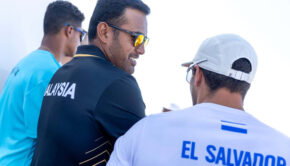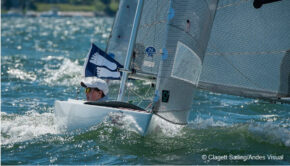Getting from here to there
Published on November 22nd, 2023
Once the Race Committee issues the course, that’s when the fun begins. Each race is different, and regardless of the outcome, the goal is to understand what happened. Don Finkle with RCR Yachts shares an example in this report:
Recently a few racers were hanging out at the bar and one asked what we talk about on our boats once the race is over. I said we review what went wrong while it was fresh in our minds. Another mentioned a prominent hockey coach he knew who said that if you always talk about what went wrong you will continue to make those same mistakes. Not sure I buy into that idea.
There are destructive and constructive ways to provide feedback and debrief. You can read and listen all day long, that is helpful, but often the best lessons are learned by doing. Although, beating yourself up, playing the blame game among the crew, or turning into a sourpuss after a bad race takes the fun out of it for you and everyone else. It’s not be the best way to learn either.
In my earlier days, I could get down after a bad race. Now I realize that you think more clearly with less emotion—at least I do. Right after the race, once we pass beers around for the sail back in, we review how things went. The good, the non-so-good, and even ugly if that applies.
We point out what others did too, we can learn from them as well. The goal is to take something away from every race, and when you look at a mistake as an opportunity to do better next race, it stings much less. No matter what, remember to enjoy the time on the water.
The following recap of a late season race we did is a good illustration of what we talk about after a race. It was a regular weeknight race out of Youngstown (NY), so we had local knowledge of the wind and what the others in the fleet tend to do. Normally, I am allergic to the boat end of the start line because in this fleet some of the largest and fastest boats usually crowd there, along with at least one barger. It is a high-risk place to be.
So, our typical start might be mid-line, enough below the fastest boats so by the time they might roll us we can safely tack out. On this night, the way things were shaping up, we had a rare opportunity to start right at the boat with speed. So far, so good.
A faster boat to leeward began to affect us so we tacked out to the right. The idea was to go a short way and then head back to the usually-favored left side. However, as we continued on port tack we began to look better and better against the others on the left side so we hung in way too long.
Then the predictable happened. We may have been sailing with good speed but when we tacked back to starboard toward the layline, the boats that had gone left were all going to cross us. Mistake number one: we should have tacked back to starboard shortly after the clearing tack after the start. Mistake number two: misjudging the layline to the weather mark.
We sail this course enough to know that in this wind direction, there is a modest foul current at the first mark and you need to put some distance in the bank before getting to the layline.
As we neared the mark, it became apparent we had two ugly choices: struggle to get to the mark by sailing skinny or take two tacks into a crowd of boats above us. We chose the former and managed to ooch around the mark. However, by losing so much speed to make the mark we had a slow start to the downwind leg.
Fortunately, we sailed the run well and ended up making good distance on boats that held too high. We had a good inside spot at the leeward mark when I made mistake number three. I told the crew we would tack after rounding. So, as we rounded, I shot high for a bit on port to give us a bit of room on boats below but the crew thought we were tacking right then and began to pull the jib around.
However, what I meant, and should have said was, “We will tack after rounding once we have a nice lane back to the left.” We fell back onto port to gain speed heading to the right, forgetting the lesson of the first beat.
Instead of tacking back, we continued to the right because our boat speed was good and we had clear air. Another mistake: we got our heads inside the boat and ignored the overall situation. By now, we had worked our way back in the fleet and the rest of the race continued without much change.
Once finished, we had a quick debrief. We had a good start and our boat speed was good. With one exception, our boat handling was also good. It was a beautiful night, and after too many nights of no wind or thunderstorm cancellations, we were really pleased to have nice conditions for a change.
I recounted the mistakes, all of which were on me. In retrospect I think my crew, who are good sailors, were too deferential to me and should have questioned why we were doing some of the things we were doing. We all understood what had happened, once it was over. We still had a good time.
We include the above recap as an illustration that a race is not as simple as going from here to there. A race contains many decisions from start to finish and those who do well make the fewest mistakes.









 We’ll keep your information safe.
We’ll keep your information safe.